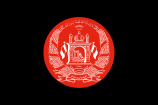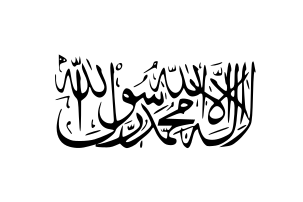Flag of Afghanistan
 | |
| Proportion | 2:3 |
|---|---|
| Adopted | 2013 |
| Design | Three vertical bands of black, red and green with the National Emblem in white centered on the red band and then slightly overlapping the Black and Green bands. |
 | |
| Use | Presidential Standard |
| Proportion | 2:3 |
| Adopted | 2013 |
| Design | A black field with the large red disk in the center bearing the National Emblem in white. |
The national flag of Afghanistan (Pashto: د افغانستان رپی; Dari Persian: پرچم افغانستان)[1] consists of a vertical tricolor with the classical National Emblem in the center. The current flag was adopted on August 19, 2013, but many similar designs had been in use throughout most of the 20th century.
The black color represents its troubled 19th century history as a protected state, the red color represents the blood of those who fought for independence (specifically, the Anglo-Afghan Treaty of 1919), and the green represents hope and prosperity for the future.[2][3]
Afghanistan has had 26 different flags since the first flag when the Hotaki dynasty was established in 1709. During the 20th century alone, Afghanistan went through 19 different national flags, more than any other country during that time period,[4][5] and most of them had the colors black, red, and green on them.[4]
Historical flags
| Flag | Years of use | Ratio | Government | Notes |
 |
1709–1738 | 2:3 | Hotak dynasty | |
| 1747–1842 | 2:3 | Durrani Empire | Flag flown under the rule of Ahmad Shah Durrani and his dynasty. | |
| No official flag during this period. | 1842–1880 | Emirate of Afghanistan | Prior to 1880, the Barakzai dynasty did not use the flag associated with the Durranis, or an official alternative. | |
.svg.png) |
1880–1901 | 2:3 | Emirate of Afghanistan | Flag flown under the rule of Abdul Rahman Khan. |
.svg.png) |
1901–1919 | 3:5 | Emirate of Afghanistan | State and war flag flown under the rule of Habibullah Khan. Habibullah added to his father's flag a seal that is the precursor of the modern-day seal. |
.svg.png) |
1919–1926/29 | 2:3 | Emirate of Afghanistan | First flag flown under the rule of King Amanullah. He expanded upon his father's flag by adding rays emanating from the seal in the form of an octagram. This new style of seal was common in the Ottoman Empire. Afghanistan became a kingdom in 1926. |
.svg.png) |
1926–1928 | 2:3 | Kingdom of Afghanistan | Second flag flown under the rule of King Amanullah. He replaced the octagram with a wreath and slightly modified the national seal. |
.svg.png) |
1928 | 3:5 | Kingdom of Afghanistan | Third flag flown under the rule of King Amanullah. The black, red, and green tricolor, respectively representing the past (previous flags), the bloodshed for independence (Third Anglo-Afghan War), and hope for the future, was probably influenced by Khan’s visit abroad to Europe and especially Germany (black-red-gold) in 1927. |
.svg.png) |
1928–1929 | 2:3 | Kingdom of Afghanistan | Fourth flag flown under the rule of King Amanullah. The new seal shows the sun rising over two snow-capped mountains, representing a new beginning for the kingdom. |
.svg.png) |
1929 | 2:3 | Kingdom of Afghanistan | Flag flown under the rule of Habibullah Kalakani. The red, black, and white tricolor. |
.svg.png) |
1929 – March 27, 1930 | 2:3 | Kingdom of Afghanistan | First flag flown under the rule of Nader Shah. The black, red, and green tricolor was re-established; the octogram seal borrowed from the first flag of King Amanullah replaced the sun and mountains seal. |
.svg.png) |
March 27, 1930 – July 16, 1973 | 2:3 | Kingdom of Afghanistan | Second flag flown under the rule of Nader Shah, it was also used by his son, Zahir Shah. The black, red, and green tricolor were retained. The octagram rays were removed, and the seal enlarged. In between the mosque and the seal is the year ١٣٤٨ (1348 of the lunar Islamic calendar, or 1929 AD of the Gregorian calendar) the year Mohammed Nadir Shah’s dynasty began. |
.svg.png) |
July 17, 1973 – May 8, 1974 | 2:3 | Republic of Afghanistan | First flag flown for the Republic of Afghanistan. It is identical to the previous flag, except that the year ١٣٤٨ was removed as Zahir Shah's monarchy ended. |
.svg.png) |
May 9, 1974 – April 26, 1978 | 2:3 | Republic of Afghanistan | Second flag flown for the Republic of Afghanistan. The same colors were used, but the meanings reinterpreted: black for the obscure past, red for blood shed for independence, and green for prosperity from agriculture. In the canton is a new seal, with an eagle with spread wings, a pulpit (minbar) on the eagle’s chest (for a mosque), wheat surrounding the eagle, and the sun’s rays above the eagle (for the new republic). |
.svg.png) |
April 27, 1978 – October 18, 1978 | 2:3 | Democratic Republic of Afghanistan | When the leader of the republic, Mohammad Daoud Khan, was killed in a coup, the new regime under the People's Democratic Party of Afghanistan (PDPA), with the assistance of the Soviet Union, established a secular socialist state. For a brief period of time, during the transition, the same flag design was kept, but no seal. A similar flag was used by the Junbish-e Milli party which controlled autonomous northern Afghanistan from 1992 to 1998. |
.svg.png) |
October 19, 1978 – April 21, 1980 | 1:2 | Democratic Republic of Afghanistan | This flag used a red field with a yellow seal in the canton, a common design for socialist states in the 20th century. The wreath of wheat remained, but a star was added at top (representing the five ethnic groups of the nation) and the word 'Khalq' in Arabic script in the center. The flag was also the flag of the PDPA's Khalq faction under President Nur Muhammad Taraki until his murder in September 1979. |
.svg.png) |
April 22, 1980 – November 29, 1987 | 1:2 | Democratic Republic of Afghanistan | After the overthrow of the Khalq faction by the Parcham faction, the flag was changed again. The overthrow occurred in December 1979 days before the start of the Soviet war. The new leadership re-established the black, red, and green tricolor, representing the past, blood shed for independence, and the Islamic faith, respectively. A new seal was designed, with a rising sun (a reference to the former name, Khorasan, meaning "Land of the Rising Sun"), a pulpit and a book (considered to be the Communist Manifesto or Capital by Karl Marx), ribbons with the national colors, a cogwheel for industry, and a red star for communism. |
.svg.png) |
November 30, 1987 – April 26, 1992 | 1:2 | Republic of Afghanistan | The flag was changed as part of Mohammad Najibullah's National Reconciliation constitution changes. Same as the previous flag, except that in the national seal, the cogwheel is moved from the top to the bottom, the red star and the book are removed, and the green field curved to resemble the horizon. |
.svg.png) |
April 27, 1992 − December 6, 1992 | 1:2 | Islamic State of Afghanistan | This flag was used as a provisional flag after the fall of the Najibullah pro-Soviet regime. It appeared in many variants of which one is shown here. In the upper stripe is Arabic Allahu Akbar, ("Allah is the greatest"); the center stripe contains the Shahadah. |
.svg.png) |
December 7, 1992 – November 12, 2001 (de jure) September 26, 1996 (de facto) |
1:2 | Islamic State of Afghanistan / Northern Alliance (de jure) | The new Islamic government under Rabbani featured a flag change. This design is similar to several Middle Eastern Muslim nations' flags. Also, the Shahadah is written within a logo. On the bottom part of the logo was written "دا افغانستان اسلامی دولت", Islamic State of Afghanistan. |
.svg.png) |
September 27, 1996 – October 26, 1997 | 2:3 | Islamic Emirate of Afghanistan | A plain white flag was flown by the Taliban. |
 |
October 27, 1997 – November 12, 2001 | 2:3 | Islamic Emirate of Afghanistan | In 1997 the Taliban introduced the Shahadah on a white flag.
د افغانستان اسلامي امارات |
.svg.png) |
November 13, 2001 – January 27, 2002 | 1:2 | Islamic State of Afghanistan | |
.svg.png) |
January 28, 2002 – January 3, 2004 | 1:2 | Transitional Administration | After the fall of the Taliban, the traditional black, red and green colors were restored. The center emblem is the classical emblem of Afghanistan with a mosque with its mihrab facing Mecca. This flag is similar to the one flown in Afghanistan during the monarchy between 1930 and 1973 - the difference is a revised emblem including the addition of the shahadah at the top of the coat-of-arms (seen in white) in the center. It now shows the year ١۲۹٨ (1298), the solar Islamic calendar equivalent of AD 1919 of the Gregorian Calendar, the year of independence from the UK. There was an unofficial variation with a gold emblem. |
.svg.png) |
January 4, 2004 – August 19, 2013 | 2:3 | Islamic Republic of Afghanistan | Similar to the previous flag, but a different ratio and a slightly moderated emblem. "دا افغانستان اسلامی دولت" Islamic State of Afghanistan has been replaced with simply "افغانستان" Afghanistan. |
 |
August 19, 2013 – present | 2:3 | Islamic Republic of Afghanistan | This flag incorporates the tweaked national emblem which overlaps into the black and green bars instead of being completely contained in the red bar, making it look more similar to the 1930–1973 monarchy-era flag. |
See also
References
- ↑ http://www.flagscorner.com/afghanistan-flag/
- ↑ "Flag of Afghanistan".
- ↑ "Afghanistan Flag - colors & meaning - history & info". afghanistanflag.facts.co. 19 January 2018.
- 1 2 "Afghanistan". The World Factbook. Central Intelligence Agency. November 14, 2017. Retrieved November 30, 2017.
- ↑ "Historical Flags (Afghanistan)". flagspot.net.